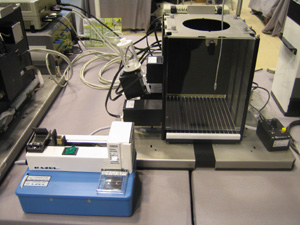
Operant & Behavior Modular System
An entirely modular experimental enclosure designed to conduct operant conditioning procedures (e.g. food reinforcement, DMTS, conflict...
 Pain - Thermal Allodynia / Hyperalgesia
Pain - Thermal Allodynia / Hyperalgesia Pain - Spontaneous Pain - Postural Deficit
Pain - Spontaneous Pain - Postural Deficit Pain - Mechanical Allodynia / Hyperalgesia
Pain - Mechanical Allodynia / Hyperalgesia Learning/Memory - Attention - Addiction
Learning/Memory - Attention - Addiction Physiology & Respiratory Research
Physiology & Respiratory Research
An entirely modular experimental enclosure designed to conduct operant conditioning procedures (e.g. food reinforcement, DMTS, conflict...
Discover our products
Meet Audrey and Anne on Booth #14 at the OARSI meeting 2024 in Vienna, Austria, Apr....
Discover our news
| Food-motivated operant conditioning test Progressive-ratio (PR) schedules permit studying food-motivated behavior. These schedules require an increasing number of operant responses to obtain successive rewards within a session. For example, a typical PR 5 schedule requires five responses to produce the first reinforcer, and the response requirement is incremented by five each time a reinforcer is earned. The breaking point, defined as the highest ratio completed is a classical measure reflecting the efficacy or motivational strength of food, and is increased in response to food-deprivation or reward high palatability. | Self-administration test Self administration is a classical model of human drug-taking behavior and consists in establishing in rodents an operant conditioning of an instrumental response (nose-poke, lever pressure) to obtain a reward, according to a fix or progressive ratio. Self administration is a standard paradigm for studying the acute rewarding properties of drugs, the development of habitual drug-seeking behaviors, and ultimately, addiction. Moreover, this method can be used to assess the abuse potential of drugs. | Geller Seifter test The Geller-Seifter paradigm is a conflict model in which prior food-deprived rodents have to “choose” between consuming food and avoiding the punishment associated with this consumption. Basically, periods of responding by lever pressing to get sweetened condensed milk on a variable interval schedule are interrupted by periods where, in the presence of a signal, reward can be obtained more frequently but are accompanied by mild footshocks. Levels of punished responding are inversely proportional to the level of anxiety. Then, in this context, the shock-induced reduction of reward seeking can be reversed by administration of anxiolytics. |
• Number of responses (LE 85XCT) • Number of reinforcements (LE 85XCT) • And many user-defined parameters (see PackWin software) • Entirely modular system • Easily transformed from rat to mice chamber • Reduced number of cables • Possibility of customization • Up to 8 stations can be connected at once to PC through a single cable | • Anxiety • Drug screening • Phenotyping • Anhedonia • Drug dependence • Alcohol dependence • and much more... |
A standard experimental chamber for automated or manual assessment of conditioned place preference and aversion in rodents...
check_circle
check_circle